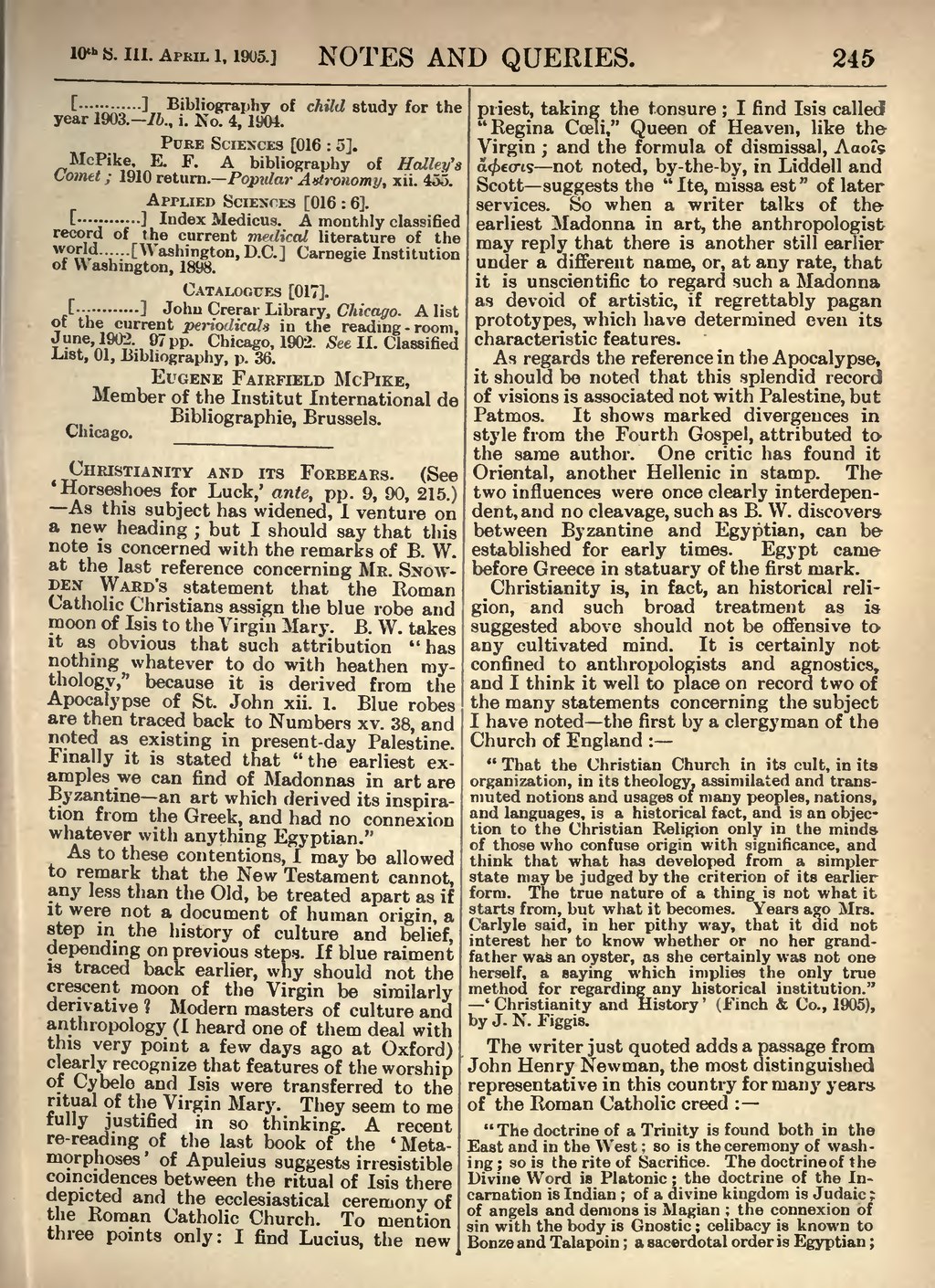in. APRIL i,i905.] NOTES AND QUERIES.
245
[ ] Bibliography of child study for the
year 1903. lb., i. No. 1, 1904.
PURE SCIENCES [016 : 5].
McPike, E. F. A bibliography of Halley's Comet ; 1910 return. Popular Astronomy, xii. 455.
APPLIED SCIENCES [016 : 6]. [............] Index Medicus. A monthly classified
record of the current medical literature of the
- 7Ey";-" Wa8llin S ton DXX] Carnegie Institution
of V\ ashington, 1898.
CATALOGUES [017].
[ ] John Crerar Library, Chicago. A list
ot the current periodicals in the reading-room, June 1902 97pp. Chicago, 1902. See II. Classified -List, 01, Bibliography, p. 36.
EUGENE FAIRFIELD McPiKE, Member of the Institut International de
Bibliographic, Brussels. Chicago.
CHRISTIANITY AND ITS FORBEARS. (See 'Horseshoes for Luck,' ante, pp. 9, 90, 215.) As this subject has widened, 1 venture on a new heading ; but I should say that this note is concerned with the remarks of B. W. at the last reference concerning MR. SNOW- DEN WARD'S statement that the Roman Catholic Christians assign the blue robe and moon of Isis to the Virgin Mary. B. W. takes t as obvious that such attribution "has nothing whatever to do with heathen my- thology," because it is derived from the Apocalypse of St. John xii. 1. Blue robes are then traced back to Numbers xv. 38, and noted as existing in present-day Palestine. Finally it is stated that "the earliest ex- amples we can find of Madonnas in art are Byzantine an art which derived its inspira- tion from the Greek, and had no connexion whatever with anything Egyptian."
As to these contentions, I may be allowed to remark that the New Testament cannot, any less than the Old, be treated apart as if it were not a document of human origin, a step in the history of culture and belief, depending on previous steps. If blue raiment is traced back earlier, why should not the crescent moon of the Virgin be similarly derivative 1 Modern masters of culture and anthropology (I heard one of them deal with this very point a few days ago at Oxford) clearly recognize that features of the worship ot Cybele and Isis were transferred to the ritual of the Virgin Mary. They seem to me tully justified in so thinking. A recent re-reading of the last book of the 'Meta- morphoses ' of Apuleius suggests irresistible coincidences between the ritual of Isis there depicted and the ecclesiastical ceremony of the Roman Catholic Church. To mention three points only: I find Lucius, the new
priest, taking the tonsure ; I find Isis called
"Regina Coali," Queen of Heaven, like the
Virgin ; and the formula of dismissal, Aaots
a$eo-ts not noted, by-the-by, in Liddell and
Scott suggests the "Ite, missa est" of later
services. So when a writer talks of the
earliest Madonna in art, the anthropologist
may reply that there is another still earlier
under a different name, or, at any rate, that
it is unscientific to regard such a Madonna
as devoid of artistic, if regrettably pagan
prototypes, which have determined even its
characteristic features.
As regards the reference in the Apocalypse, it should be noted that this splendid record of visions is associated not with Palestine, but Patmos. It shows marked divergences in style from the Fourth Gospel, attributed to the same author. One critic has found it Oriental, another Hellenic in stamp. The two influences were once clearly interdepen- dent, and no cleavage, such as B. W. discovers- between Byzantine and Egyptian, can be established for early times. Egypt came before Greece in statuary of the first mark.
Christianity is, in fact, an historical reli- gion, and such broad treatment as is suggested above should not be offensive to any cultivated mind. It is certainly not confined to anthropologists and agnostics, and I think it well to place on record two of the many statements concerning the subject I have noted the first by a clergyman of the Church of England :
" That the Christian Church in its cult, in its organization, in its theology, assimilated and trans- muted notions and usages of many peoples, nations, and languages, is a historical fact, and is an objec- tion to the Christian Religion only in the minds of those who confuse origin with significance, and think that what has developed from a simpler state may be judged by the criterion of its earlier form. The true nature of a thing is not what it starts from, but what it becomes. Years ago Mrs. Carlyle said, in her pithy way, that it did nob interest her to know whether or no her grand- father was an oyster, as she certainly was not one herself, a saying which implies the only true method for regarding any historical institution." 'Christianity and History' (Finch & Co., 1905), by J. N. Figgis.
The writer just quoted adds a passage from John Henry Newman, the most distinguished representative in this country for many years, of the Roman Catholic creed :
"The doctrine of a Trinity is found both in the East and in the West ; so is the ceremony of wash- ing ; so is the rite of Sacrifice. The doctrine of the Divine Word is Platonic ; the doctrine of the In- carnation is Indian ; of a divine kingdom is Judaic ; of angels and demons is Magian ; the connexion of sin with the body is Gnostic ; celibacy is known to Bonze and Talapoin ; a sacerdotal order is Egyptian ;
